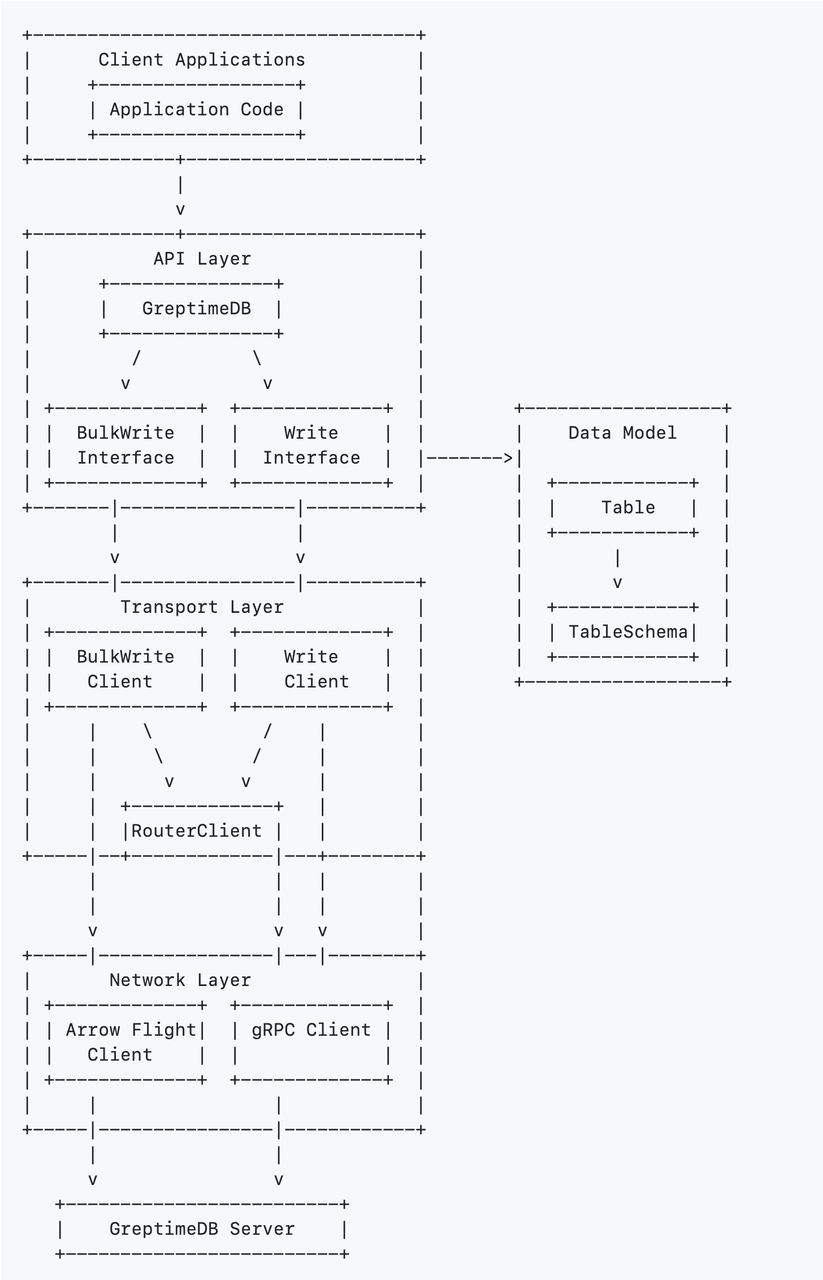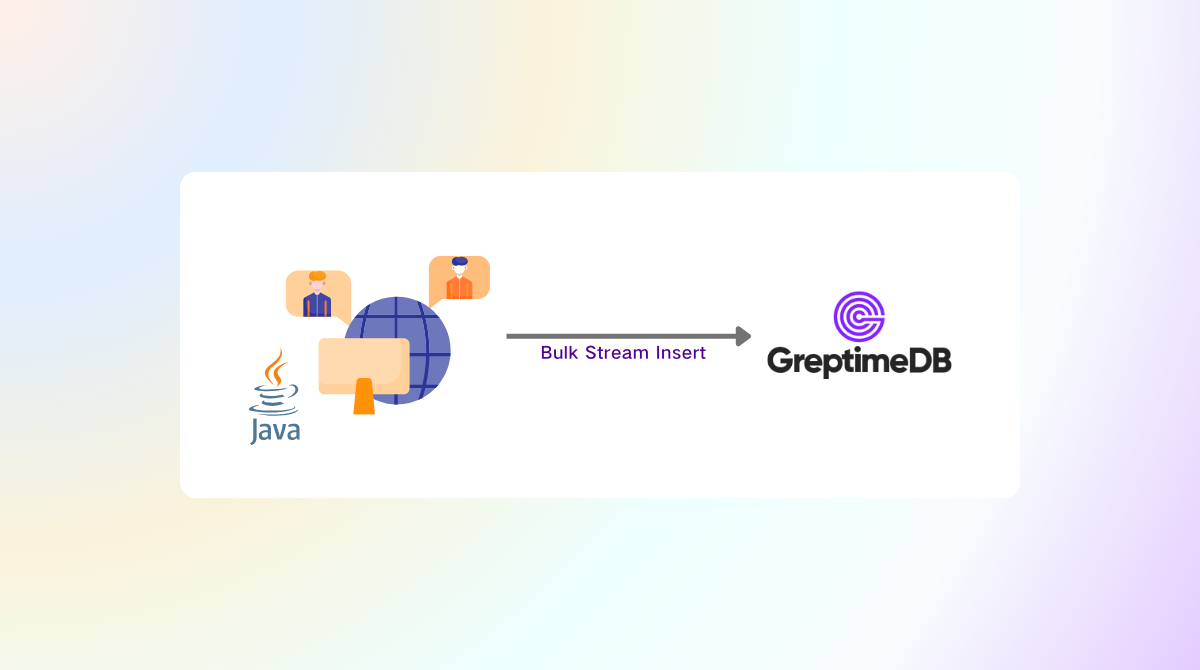Introduction
GreptimeDB is an open-source, cloud-native observability database purpose-built for metrics, logs, and traces. It delivers real-time insights at any scale, from edge to cloud.
To meet varying ingestion requirements, the GreptimeDB Java client offers two APIs:
- Regular Insert API: Optimized for low-latency writes, ideal for real-time scenarios.
- Bulk Stream Insert API: Optimized for high-throughput writes, tailored for batch ingestion.
In this article, we’ll take a deep dive into the Bulk API—covering its design, usage patterns, performance tuning options—and compare its throughput against the Regular API.
GreptimeDB Java Ingester
The GreptimeDB Ingester for Java is a lightweight, high-performance client designed for efficient time-series data ingestion. It leverages the gRPC protocol to provide a non-blocking, purely asynchronous API that delivers exceptional throughput while maintaining seamless integration with your applications.
Architecture Overview

- API Layer: Provides high-level interfaces for client applications to interact with GreptimeDB.
- Data Model: Defines the structure and organization of time series data with tables and schemas.
- Transport Layer: Handles communication logistics, request routing, and client management.
- Network Layer: Manages low-level protocol communications using Arrow Flight and gRPC.
Creating a Client
The entry point is the GreptimeDB class. A client instance is created via the static create method, configured once and reused globally:
String database = "public";
String[] endpoints = {"127.0.0.1:4001"};
GreptimeOptions opts = GreptimeOptions.newBuilder(endpoints, database)
.build();
// Initialize the client
GreptimeDB client = GreptimeDB.create(opts);Writing Data: Overview
All writes are built on the Table abstraction. The workflow:
- Define a
TableSchema. - Create a
Tablefrom the schema. - Insert rows and commit.
⚠️ Notes:
Tableinstances are immutable after completion and cannot be reused.TableSchemacan be reused and should be, to minimize overhead.
Example:
// Define schema
TableSchema schema = TableSchema.newBuilder("metrics")
.addTag("host", DataType.String)
.addTag("region", DataType.String)
.addField("cpu_util", DataType.Float64)
.addField("memory_util", DataType.Float64)
.addTimestamp("ts", DataType.TimestampMillisecond)
.build();
// Create a table
Table table = Table.from(schema);
// Insert rows
table.addRow("host1", "us-west-1", 0.42, 0.78, System.currentTimeMillis());
table.addRow("host2", "us-west-2", 0.46, 0.66, System.currentTimeMillis());
// Finalize table
table.complete();Regular Insert API
Best suited for: real-time apps, IoT sensors, and interactive systems.
Characteristics:
- Latency: sub-millisecond
- Throughput: 1k–10k rows/sec
- Network model: request-response
- Memory: lightweight, but may run out of memory under high concurrency.
Example:
// Add rows to the table
for (int row = 0; row < 100; row++) {
Object[] rowData = generateRow(batch, row);
table.addRow(rowData);
}
// Write the table to the database
CompletableFuture<Result<WriteOk, Err>> future = client.write(table);Bulk Stream Insert API for High Throughput
The Bulk API enables large-scale ingestion with maximum throughput and memory efficiency, leveraging off-heap memory management for optimized batching.
Best suited for: ETL pipelines, data migration, batch ingestion, and log collection.
Characteristics:
- Latency: 100–10,000 ms (batching)
- Throughput: >10k rows/sec
- Network model: parallel streaming, one stream per table
- Memory: stable, with built-in backpressure
Key Advantages:
- Parallel processing with multiple in-flight requests
- Streaming transmission via Apache Arrow Flight
- Zstd compression support
- Asynchronous, non-blocking commits
Usage Example of Bulk Insert API
// Create a BulkStreamWriter with the table schema
try (BulkStreamWriter writer = greptimeDB.bulkStreamWriter(schema)) {
// Write multiple batches
for (int batch = 0; batch < batchCount; batch++) {
// Get a TableBufferRoot for this batch
Table.TableBufferRoot table = writer.tableBufferRoot(1000); // column buffer size
// Add rows to the batch
for (int row = 0; row < rowsPerBatch; row++) {
Object[] rowData = generateRow(batch, row);
table.addRow(rowData);
}
// Complete the table to prepare for transmission
table.complete();
// Send the batch and get a future for completion
CompletableFuture<Integer> future = writer.writeNext();
// Wait for the batch to be processed (optional)
Integer affectedRows = future.get();
System.out.println("Batch " + batch + " wrote " + affectedRows + " rows");
}
// Signal completion of the stream
writer.completed();
}Deep Dive: Bulk API
1. Table Requirements
- Tables must be created ahead of time with SQL DDL.
- No automatic schema evolution.
- No primary key tag columns; each row must provide all columns
2. Configuration Options
The Bulk API optimizes performance with multi-configuration support:
BulkWrite.Config cfg = BulkWrite.Config.newBuilder()
.allocatorInitReservation(64 * 1024 * 1024L) // Custom memory allocation: Initially reserved 64MB
.allocatorMaxAllocation(4 * 1024 * 1024 * 1024L) // Custom memory allocation: Maximum allocation of 4GB
.timeoutMsPerMessage(60 * 1000) // Per-request timeout: 60 seconds (Throughput-optimized; moderate latency tolerance recommended)
.maxRequestsInFlight(8) // Concurrency control: Configured to allow a maximum of 10 concurrent (in-flight) requests
.build();
// Enable Zstd compression
Context ctx = Context.newDefault().withCompression(Compression.Zstd);
BulkStreamWriter writer = greptimeDB.bulkStreamWriter(schema, cfg, ctx);3. Performance Tuning Recommendations
- Compression: Zstd (recommended for network I/O bottlenecks)
- Adjust concurrency based on workload (network-bound vs CPU-intensive)
// Assuming single instance with single table writing, CPU cores = 4
// Network-Bound Scenario: Bulk Stream Insert primarily waits for network transmission
BulkWrite.Config networkBoundOptions = BulkWrite.Config.newBuilder()
.maxRequestsInFlight(8) // Recommended 8-16 to fully utilize network bandwidth
.build();
// CPU-Intensive Scenario: When significant computation is needed before writing
BulkWrite.Config cpuIntensiveOptions = BulkWrite.Config.newBuilder()
.maxRequestsInFlight(4) // Recommended to match number of CPU cores
.build();
// Mixed Workload: Adjust based on actual bottleneck
BulkWrite.Config balancedOptions = BulkWrite.Config.newBuilder()
.maxRequestsInFlight(6) // Balanced between network and CPU constraints
.build();- Tune batch size: In the Ingester system, each table essentially functions as a buffer. Small batches for lower latency, larger batches for higher throughput.
Benchmarking: Bulk vs Regular API
To demonstrate performance differences, we built a simple log ingestion benchmark using greptimedb-ingester-java.
The tool provides TableDataProvider - a high-performance log data generator designed for performance testing. It synthesizes log data with 15 fields to simulate real-world distributed system logging scenarios. The table structure is as follows 👇
Schema:
CREATE TABLE IF NOT EXISTS `my_bench_table` (
`log_ts` TIMESTAMP(3) NOT NULL,
`business_name` STRING NULL,
`app_name` STRING NULL,
`host_name` STRING NULL,
`log_message` STRING NULL,
`log_level` STRING NULL,
`log_name` STRING NULL,
`uri` STRING NULL,
`trace_id` STRING NULL,
`span_id` STRING NULL,
`errno` STRING NULL,
`trace_flags` STRING NULL,
`trace_state` STRING NULL,
`pod_name` STRING NULL,
TIME INDEX (`log_ts`)
)
ENGINE=mitoData Characteristics
Key Feature: Large
log_messagefield- Target length: ~2,000 characters
- Content generation: Template-based system that produces different message types depending on log level
Field Cardinality / Dimension Distribution
- High-cardinality fields (nearly unique):
trace_id,span_id: generated using 64-bit random numberslog_ts: based on millisecond-level timestamps
- Low-cardinality fields are not listed here in detail.
- High-cardinality fields (nearly unique):
Run Benchmark Tests
- Start GreptimeDB
- Create the table
- Sequentially run the Bulk API Benchmark and Regular API Benchmark
- Commands:
# Bulk API Benchmark
run io.greptime.bench.benchmark.BatchingWriteBenchmark
# Regular API Benchmark
run io.greptime.bench.benchmark.BatchingWriteBenchmark- My local benchmark results are as follows:
| API Type | Throughput | Duration | Improvement |
|---|---|---|---|
| Bulk API | 180,962 rows/s | 27.630 s | 83% |
| Regular API | 98,868 rows/s | 50.572 s | Baseline |
Results show:
- Bulk API achieved ~80% higher throughput.
- Regular API is ideal for low-latency, small-scale workloads.
- Bulk API excels in high-throughput, large-scale ingestion.
Bulk API Result
- === Running Bulk API Log Data Benchmark ===
- Setting up bulk writer...
- Starting bulk API benchmark: RandomTableDataProvider
- Table: my_bench_table (14 columns)
- Target rows: 5000000
- Batch size: 65536
- Parallelism: 4
// Omit irrelevant logs ...
- → Batch 1: 65536 rows processed (47012 rows/sec)
- → Batch 2: 131072 rows processed (75199 rows/sec)
// Omit part of the process logs ...
- → Batch 73: 4784128 rows processed (180744 rows/sec)
- → Batch 74: 4849664 rows processed (180748 rows/sec)
- → Batch 75: 4915200 rows processed (180699 rows/sec)
- Completing bulk write operation, signaling end of transmission
- Waiting for server to complete processing
- → Batch 76: 4980736 rows processed (180972 rows/sec)
- → Batch 77: 5000000 rows processed (181015 rows/sec)
- Finishing bulk writer and waiting for all responses...
- All bulk writes completed successfully
- Cleaning up data provider...
- Bulk API benchmark completed successfully!
- === Benchmark Result ===
- Table: my_bench_table
-
- Provider Rows Duration(ms) Throughput Status
- --------------------------------------------------------------------------
- RandomTableDataProvider 5000000 27630 180962 r/s SUCCESSRegular API Results
- === Running Batching API Log Data Benchmark ===
- Setting up batching writer...
- Starting batching API benchmark: RandomTableDataProvider
- Table: my_bench_table (14 columns)
- Target rows: 5000000
- Batch size: 65536
- Concurrency: 4
// Omit irrelevant logs ...
- → Batch 1: 65536 rows processed (17415 rows/sec)
- → Batch 2: 131072 rows processed (32031 rows/sec)
// Omit part of the process logs ...
- → Batch 73: 4784128 rows processed (98586 rows/sec)
- → Batch 74: 4849664 rows processed (98638 rows/sec)
- → Batch 75: 4915200 rows processed (98776 rows/sec)
- → Batch 76: 4934464 rows processed (97574 rows/sec)
- Finishing batching writer and waiting for all responses...
- → Batch 77: 5000000 rows processed (98868 rows/sec)
- All batching writes completed successfully
- Cleaning up data provider...
- Batching API benchmark completed successfully!
- === Benchmark Result ===
- Table: my_bench_table
-
- Provider Rows Duration(ms) Throughput Status
- --------------------------------------------------------------------------
- RandomTableDataProvider 5000000 50572 98868 r/s SUCCESS
Choosing the Right APIConclusion
GreptimeDB provides two complementary ingestion approaches:
- Regular API: low-latency, suited for real-time, small-scale ingestion.
- Bulk API: high-throughput, suited for large-scale batch ingestion and log processing.
By choosing the right API—or combining both—developers can achieve optimal scalability and performance across a wide range of workloads.


